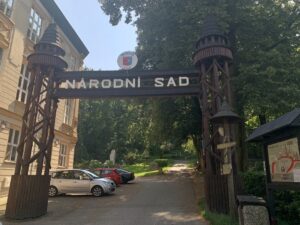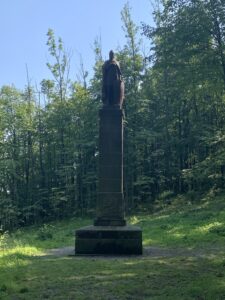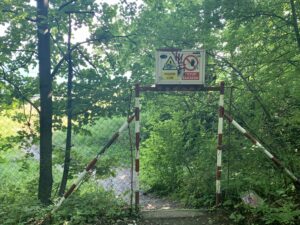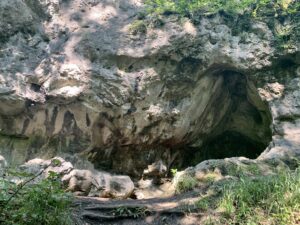Šipka Cave, Bezruč’s viewpoint with a tiny bell tower, a view of Kotouč Mountain, Jura Cave, and several monuments, statues, and busts, reminiscent of the greats of Czech history. You will see all this on an hour’s walk in the National Park, located just a few meters from our Hotel Gong.
The trail’s map is available here: https://mapy.cz/s/fegacuhema.

Entrance gate to the National Park, Štramberk
A small tour of the city Štramberk starts in front of our Hotel Gong, along which we can follow two markers – blue and yellow. Our approaching destination is the National Park. Both markers will take us here; turn right from the hotel and then turn right after about 100 meters. In front of us, we see a beautiful entrance to the National Park, which will now be followed-up by green and red markers. Then, we ascend to the right to our first stop, Šipka Cave, about 300 meters from the Park’s entrance.

Šipka Cave in the National Park, Štramberk
Šipka Cave is an important Štramberk’s historical landmark, mainly because of the Neanderthal child’s lower jaw discovered by the archaeologist Karel Maška. It only confirms that people more than 32,000 years ago inhabited the cave. Also, the remains of about 130 species of animals were found here, which proves that once the mammoths, cave lions, and bears sought their shelter here. Those archaeological findings make Šipka Cave one of the most significant objects in Štramberk’s karst.
The second short stop of our walk is only a few tens of meters above the cave. We go up the stairs, turn right, and after a while, we meet a beautiful viewpoint named after the Moravian poet Petr Bezruč. We can see the whole city of Štramberk, and there is also a functional tiny bell tower by this hidden lookout.

Statue of St. Wenceslas in the National Park
From the tiny bell tower, we turn back and continue along the green and red markers upwards to Kotouč mountain’s viewpoint, which is located about 300 meters from the bell tower. Along the way, we pass the monument of Holy Cross, a bust of Leoš Janáček, a Czech famous composer, and a statue of St. Wenceslas. As soon as we reach the lookout point, we see Kotouč Mountain, which is 511 meters high. Since the end of the 19th century, limestone has been mined here, and it was even one of the most crucial stone pits in the whole of Austria-Hungary! That’s why the hill is chopped off now. On the viewpoint, there is also a bust of Bedřich Smetana, the other famous Czech composer.

Entrance gate to the stone pit Kotouč Štramberk
According to the markings, we continue down from the viewing point until an open gate in front of us. Although the signs look a bit warning, you can enter and look at the Kotouč stone pit itself if you are not afraid of heights. The view is breath-taking (check our gallery), but of course, the entrance is only at your own risk. Kotouč Štramberk is a production plant of the Cemix company that produces ground limestone, quicklime, or cinder here.

Rock formation Jura stone in the National Park, Štramberk
We are slowly approaching our last stop, and that is Jura Cave. After Kotouč stone pit’s views, we reconnect to our trails’ red and green markers, and we continue down the hill by a wide forest path. About 200 meters later, we see a rock formation on the right side called Jura Stone, from which Jura Cave also arises. We must turn right from the path to visit the Cave and carry onto the steep slope, but the hike pays off twice. Why? Besides, there is also a bust of František Palacký under the Cave, a famous Czech historian, and politician, the most influential person of the Czech National Revival, who is also portraited on one of our banknotes!
As soon as we return to the forest path, we continue down the red and green trail. We pass the bust of writer Alois Jirásek, the memorial plaque of legionary Jan Čapek, and the memorial of general Jan Žižka of Trocnov. When we reach the bust of Tomáš Garrigue Masaryk, the first president of Czechoslavakia, we turn left to extend the trip along a lovely forest path. We follow the green markers, which after 350 meters in a place called Plaňava, turns into a red trail again. After 500 meters, we come to the familiar entrance gate to the National Park, from which it is only a few steps back to the Hotel Gong.